








This story by Nicholas Adams is published in SOM Journal 9, the ninth installment in a continuing series that highlights the conceptual undercurrents being developed at SOM.
Few architects have had a more fortuitous entrance into the profession than Gordon Bunshaft (1909-1990): education, travel, employment before World War II. He returned from the war to a job with a firm that had thrived in his absence, proving itself in large construction projects for the government. He designed for a society keen for his vision and with a pair of bosses willing to allow him the freedom to design to his own exacting standards. Is the rest just history, or was the career of Gordon Bunshaft a model for how a person can adapt over time, demonstrating different modes of leadership in new situations?
Gordon Bunshaft was, of course, a man defined by the era in which he lived and worked. He behaved like a titan of industry, a decisive army general, an architectural John Wayne. His gruff manner, silences, and staccato syllogistic explanations are remembered vividly by those who knew him. Bunshaft’s comments were terse. He had come up with the rational solution; discovered the missing element a program needed; decided what the client wanted; or, at any rate, what the client now understood he required. There was no call for him to say more. These were fortuitous times?—?there were SOM salesmen who loved the limelight, and modern architecture seemed to speak for itself: Bunshaft remained silent. For a decade or more, indeed, it was the kind of architecture that everyone wanted. Gordon Bunshaft was SOM’s one and only design partner until 1960.
Gordon Bunshaft took his name and reputation, founded on the skin and bones of Lever House (1952), Manufacturers Trust (1954), and Chase Manhattan (1961), and developed a new architecture of concrete. He listened and questioned and learned. He was still gruff, occasionally crude, prone to pipe-sucking silences, pushing questions away with the same brief answers: it had to be done; it was the logical solution; it offered an opportunity we couldn’t pass up. Though he was no longer the only design partner at SOM and often scorned his fellow partners, Bunshaft was its acknowledged leader. He joked that the only reason his name was not on the masthead was that then the initials of the firm would be S.O.B.
When the headwinds grew stronger in the 1970s Bunshaft was still Bunshaft, a difficult person who spoke little, wrote less, and who delivered personal judgments that cut to the quick, fighting a rear-guard action to keep postmodernism at bay. He was still pushing questions off at arm’s length, where they would be left to die. As he came to the end of his career at SOM, some thought having outstayed his welcome, Bunshaft could still rise to challenges, seeking out younger employees when it suited him, producing original work that often received high praise. And then he was gone?—?retired in 1979 and dead 11 years later.
Bunshaft left behind remarkably little beyond his buildings. There are a few drawings in his hand, mostly from his student days, very few alternative schemes to show how he thought through problems, no essays or lectures, and the surviving interviews reveal only the familiar staccato. The destruction of his house on Long Island (1963) in 2008 removed the last vestige of his personal life that might have been picked over for clues, and the Museum of Modern Art has dispersed much of the art collection he gave them. His family?—?there were no children?—?is unwilling to talk on the record about this complicated man. So to understand how he stayed on top?—?and to evaluate what he meant to the firm that never bore his name?—?we are left to talk with people who knew the public Bunshaft and to study the correspondence he left behind.
The Early Years
Of course it was the times. When he returned to SOM after World War II, cultural tastes had begun to form around modern architecture, pushed by the Museum of Modern Art and sustained by wealthy patrons, advocated in magazines, and appreciated by a generation that wanted to turn their back on the prewar ways. So a firm that could make it its business to offer something new was itself newsworthy. “Skid’s Boys”?—?as they were referred to in Fortune magazine, in 1958?—?purportedly embodied the kind of selfless teamwork that had licked the Germans and defeated the Japanese; an office without individual will, wholly in tune with the wishes of its clients and the country, each employee a perfect demonstration of William H. Whyte’s “organization man.” The fact that SOM did not release the names of its designers and advertised itself as “design by committee” or “design by conference,” made the firm an architectural reflection of corporate culture, that favored the social ethic of the group.
In the catalogue for the Museum of Modern Art exhibition of 1950 celebrating their work?—?a special honor as it was the first exhibition at the museum dedicated to the work of one firm (as opposed to an individual architect)?—?SOM was presented as being animated by two disciplines: “the discipline of modern architecture and the discipline of American organizational methods.” Bunshaft must have gone along with this approach when he came back after the war. But a decade or more later, and shortly after the appearance of the Fortune magazine article, it had begun to grate on him. A year later, in Newsweek, Bunshaft denied the notion that there was something called “design by committee. There always has to be one dominant force, someone who comes up with the original design.” Later in the same article he was quoted as saying: “I’m in charge of design. The other partners also participate in designing, but by criticism.” His fellow partners censured him for these comments.
Despite this, he was indispensable and the partners wanted him, perhaps they needed him. Well adapted to the times as he was, they allowed Bunshaft to establish a common standard for design for the whole firm. He was very good. The English architect John Winter (b. 1930) describes meeting Bunshaft at the San Francisco office in 1958. Winter had been working for weeks on an intractable problem (Bank of California, Sacramento) and “heard that the great Gordon Bunshaft was coming out from the New York office to visit. Word quickly went round the office and we were all very excited. I had expected just a tough businessman and not much more than that but when he arrived he was so impressive. I showed him my Sacramento project and explained the problem. He got out his pencil and with a few scribbles in 30 seconds he solved the whole thing.” As his senior designer Roger Radford (SOM 1953-1990) commented: “ I suppose the dominance that Bunshaft exerted in New York meant that really all the buildings of any consequence had his stamp.” To the list of 38 buildings that Bunshaft claimed as his own, add those where his influence or intervention cannot be doubted: it just looks like Bunshaft was there.
To these, then, add some of the designs from across the country undertaken by other offices. Some of these interventions are well known, such as Inland Steel, Chicago (1957), or the Air Force Academy, Colorado Springs (1958); some are less well known, such as the Veterans Memorial Coliseum, Portland (1957). Even buildings where there is no evidence that he gave an opinion, such as the Crown-Zellerbach Building, San Francisco (1959), depend on Bunshaft?—?which is to say that within SOM he was freely acknowledged as the creator of its vernacular. Not the vernacular of the innocent or the untrained, not just a modernist vernacular, but a firm-wide vernacular. In 1960, Architectural Forum published an article illustrating prototypical SOM detailing. Entitled “Details of Distinction,” the article documented ceilings, window walls, and door frames from Bunshaft’s major buildings: Union Carbide, Connecticut General, Manufacturers Trust, Lever House, Reynolds Metal Corporation. The article also included buildings not traditionally associated with Bunshaft but where he?—?or his associates?—?had a significant influence: Inland Steel, Chicago (Walter Netsch, Bruce Graham, 1957), the Hartford Fire Insurance Building, Chicago (Bruce Graham with Natalie de Blois, 1961) and Warren Petroleum, Tulsa (Bruce Graham, 1957). “From these detailed studies,” the author notes, “emerges a finished building that holds few surprises?—?excepting the surprise of seemingly effortless perfection.” And there was Ezra Stoller’s particular style of photographing Bunshaft buildings that the other partners wanted for their buildings, a style that conspired to make buildings that were not identical, look similar.
Metamorphosis
If the 1950s made Bunshaft’s reputation (and allowed him to think his reputation might eclipse the firm for which he worked), the second and third decades demonstrated his ability to change, something neither his early career nor his personality prepares one to expect.
There were new tastes to be accommodated. In April 1954 Bunshaft commented on the future of architecture: “Why should we be in such a rush to abandon rectangular buildings? Why don’t we build a few good ones?” Less than four years later, in January 1958, Nathaniel Owings assured an interviewer: “This firm is not stuck with the stainless-steel standard,’ as our competition calls it. We’re interested in plasticity, and we’re exploring every avenue to get it.” Whether it was Mies with Seagram or Le Corbusier at Ronchamp and Chandigarh, or the maturing of Bruce Graham and Walter Netsch in Chicago and Chuck Bassett in San Francisco?—?a thousand flowers bloomed. The quest for change required a response from the gruff master. The years of collaboration with Paul Weidlinger (1914-1999) not only produced a new kind of architecture but also a new Bunshaft. Leon Moed (SOM 1954-1991) recalls that this form of collaboration required different qualities from Bunshaft. The imperative of change obligated him to adopt the interrogative. The technologies of the curtain wall were well known to him. He might press here or there, but he knew roughly what was possible and what was not possible.
But concrete was another matter. In the 1950s, Bunshaft postponed extensive consultation with engineers until the design was well advanced, but with Weidlinger, he recognized the desirability of early coordination: “We knew we could do all sorts of things using concrete but we needed education. As soon as we got some rough ideas, the senior designer and Paul and I?—?mostly Paul and I?—?would get together. Sometimes Paul would say, You can’t do this,’ but he never made design suggestions.” Leon Moed who worked closely with Bunshaft from the late 1960s, describes Weidlinger as “a real collaborator,” something the decisive Bunshaft had never needed before.
Bunshaft’s ability to master this shift in style?—?not just architectural style, but style of production—allowed him to maintain his position of authority at SOM. He had changed with the times. Almost instantaneous success at the Emhart Corporation, Bloomfield, Connecticut (1963), and the Beinecke Library, New Haven (1963), proved that Bunshaft had more than one gear. He was not SOM’s chief designer any longer and never again commanded its vernacular, but he could still act with authority. He could parcel out his resources. When, in 1963, the San Francisco office wanted to work with Davis Allen on the interiors for the Mauna Kea Resort (1965), they sought advice from William S. Brown, the head of SOM’s office in New York. On his approval, they then asked permission of Gordon Bunshaft to approach Davis Allen about working on the project. Allen then brought to Mauna Kea some of the aesthetic he had managed to insert (with Bunshaft) into the Chase Manhattan Bank (1961), so that if it wasn’t Bunshaft, it wasn’t not Bunshaft either. Indeed the ubiquity of Davis Allen became another manifestation of Bunshaft’s taste and style. After reading an article on interiors designed by the Chicago office in Interiors (January 1959) one has some doubts as to whether, as claimed in the article, there was a distinctive “Chicago” style of interior design.
Yet it is important not to characterize Bunshaft too broadly. The stereotypical Bunshaft is just a little too easy to grasp: the decisive man in the corner office, the man who convinced with conviction, who could be hard on his colleagues. Once he sent Natalie de Blois home to change her clothes (he did not like the color green?—?didn’t everyone know that SOM didn’t use green?); he turned his back on anyone he wished not to speak with?—?whether a partner or a partner’s wife. Even his tone toward his own wife, Nina, could sometimes leave those within earshot feeling compassion for her. How could she put up with that treatment? But it was not kick down and kiss up?—?his bluntness was equal opportunity. Bunshaft was not afraid to speak truth to power, as his letter to Lyndon Johnson about one of the exhibitions at Johnson’s Presidential Library reveals: “The only sour note in your Library, it seems to me, is the Political Campaign Exhibit. The subject is a fine one but the exhibit seems to have been done without the slightest sense of design or regard for the space or walls It all looks like a poor trade show.” Johnson’s reply was gracious.
Bunshaft could spot talent; he would draw people into his circle and reward them. After Roger Radford undertook the programming of a commission in Bunshaft’s absence, he was pulled aside by the great man: “I was leaving the office to go to lunch, and he was with me then and he said, “Where are you going to lunch?” And I said, “I don’t know.” He said, “Well, let’s go over here.” So we went to some sandwich shop, and we talked a little ” Bunshaft asked about his background, his training, and his interests in architecture. “And in the discussions that we had,” goes on Radford, “it was always a give and take. It was always a give and take. And continued to be, throughout the following years, you know.” Although, he admitted, “sometimes it was more give than take, and sometimes ” Others report the same experience: when Bunshaft saw something he liked, the door opened.
In preparing designs for the National Commercial Bank, Jeddah, the senior designer on the project Tom Killian (SOM 1963-1990) reports that Bunshaft took an initial dislike to him. (“You’re the guy that does triangles.”) Later Bunshaft saw Killian’s proposal for stacked “V’s” and liked what he saw and pulled him into the project. Later still, as the project approached completion, Killian’s partner, the architect Françoise Bollack, saw the design and commented that the reveal for the ventilation register, which served visually as a kind of molding, was inappropriately cut in at the corners. Bunshaft agreed and the completed building is without them. Nonetheless, he could reach out even when his own interests were not being directly served. In 1971, Linda Flannery, a disgruntled employee leaving SOM, wrote a long letter to Bunshaft lamenting the firm’s lack of support for design and criticizing the business-minded mentality of the newer partners. “Mr. Bunshaft,” she wrote, “you are the only partner who is respected, without exception by everyone in the this firm.” She appealed to him to revitalize the firm. “I’m sure you must care about the firm and it future and that underneath all your gruffness have a true concern for your employees ” What Bunshaft said to her, or indeed if he spoke to her at all, is not known, but penciled on the letter are phone numbers. Bunshaft clearly tried to call her?—?and thought the letter worth preserving. Was he telling us something about himself? Or did Bunshaft want his correspondent to say what could not say openly about his colleagues?
Art and the Architect
One aspect of Bunshaft’s work still needs to be assessed. What does it say about him that he was so close to a number of prominent artists and sculptors? Was he a different person with them? He certainly wasn’t a pushover. Despite all the talk about a “team approach,” Bunshaft ordered Natalie de Blois to redesign the northeast court at Connecticut General after he was dissatisfied with Isamu Noguchi’s proposal. Noguchi was not always happy in a collaboration with Bunshaft. “One-sided” was Noguchi’s phrase for it where “collaboration” meant bending to the architect’s will. Nonetheless, he brought a different tone to his relationships with artists. The extensive correspondence with Jean Dubuffet and Henry Moore, for example, is both playful and witty, describing cheerful conversations, and looking forward to further jovial meetings. Typical is this cover letter (July 31, 1972) to Moore sending on a review of David Mitchinson’s Henry Moore Unpublished Drawings (1972) from the New York Times. “I hope you will like the review. It seems to be very thoughtful and affectionate one, it is hard to visualize Mr. John Canaday being affectionate as he is quite a sour puss as a rule.” The correspondence with both Moore and Dubuffet, though it often deals with matters of business, could be tender. To Dubuffet he wrote (November 3 1972), after the installation of his Group of Four Trees in front of Chase Manhattan: “I enjoyed your visit here tremendously. I felt that although I have known you, off and on, for many years, this is the first time we really became closer.” And to Dubuffet Bunshaft, wrote enthusiastically (November 22, 1972): “It gave us a tremendous feeling of warmth and closeness to you.”
Were these just client-client relations? Was Bunshaft just anxious to curry the favor of those he needed to complete his architectural works; the artists keen to get on with a client whose investment mattered to them? Perhaps. Though he was at pains not to call himself a collector, his dedication to art seems to have been the one extra-architectural pleasure he allowed himself: “I don’t like the word collector.’ That’s too fancy, but it’s a kind of a disease. First you buy one or two things, and then you but more and more, and stud it wherever you can.” It was also the one area in which Bunshaft could match his interests to those of the firm. He might never be the country club architect in tweeds, but service as trustee at the Museum of Modern Art brought him into contact with progressive businessmen and he allowed his artistic interests to be part of his public image. Bunshaft relished the process of selecting the works of art to be put in the offices at Chase Manhattan and remained good friends with Seymour Knox II (1898-1990), chairman of Marine Midland Bank, in Buffalo, with whom he shared a passion for contemporary art. Knox donated a major addition (designed by Bunshaft) to the Albright Art Gallery (later Albright-Knox) in Buffalo.
Bunshaft’s correspondence with his artist-friends makes it seem as if they are all speaking the same language and maybe, in a sense, they were. Bunshaft believed that his buildings had to speak for themselves. Better yet, as he told the New York Times in 1972: “I like my architecture to speak for itself. Well, anyhow, to speak for me.” In describing the addition to the Albright addition, he commented to the Buffalo Evening News in 1962: “The building speaks for itself.” In his long interviews with Arthur Drexler, Reinhold Martin notes, he “scarcely acknowledges the intersection of architecture with analytic discourse.” A decade later, as he wrote to Owen Luder declining an invitation to deliver the first RIBA Westbourne Lecture: “I don’t like to talk to large groups so I haven’t for the past 40 years. I also believe that the buildings I have designed should speak for me.” But perhaps it was that silence that he shared with artists? His friend Jean Dubuffet thought writing about art was inevitably cold: “Written language seems to me a bad instrument. As an instrument of expression, it seems to delivery only a dead remnant of thought, more or less as clinkers from the fire.” In fact, Henry Moore had his own misgivings about delivering opinions about works of sculpture observing that “For a sculptor or a painter to speak or write, in public, about his job, very often is a mistake. It (perhaps) releases (some of the) urge and tension needed to do his work with intensity.” In the company of artists unwilling to explain their art, it was as if they justified Bunshaft’s own uncertain silences. Perhaps only in the context of SOM?—?a large firm with spokesmen and press releases, and able project managers, could it be sustained.
Bunshaft’s frequent indifference to the firm was painful to many of his fellow partners of whose talents he could be dismissive (“Owings was a brilliant salesman.”) He never successfully mentored a young designer or brought a designer of comparable skills to partnership: the office was there for his convenience, and after he went they’d just have to manage. The Chicago offices thrived as Graham, Netsch, Goldsmith and Khan matured under William Hartmann. Bunshaft initially tried to discourage Chuck Bassett, who developed independently on the West Coast, supported by Owings. In Washington, Owings helped advance David Childs. Today the “children” of Bassett, Netsch, and Childs run SOM. Only late in life did Bunshaft seem to embrace the idea of SOM as a team. On viewing the film prepared for the 50th anniversary of SOM he delivered a brief speech recalling his beginnings with the firm and critiquing the film for its focus on half a dozen individuals. “The truth of the matter,” he said, “is that we’re all very ordinary people. If we’d been on our own, we’d be nothing. The fact that we’re a team has given all of us, to different degrees, opportunities to go beyond what could have done if we hadn’t been part of this group I don’t think there are many people who come into this world who could be Corbusier or Mies or even Wright. I don’t think we’ve done a proper job in crediting all you people. That’s it.”
In the end Bunshaft remains a mystery, yet we do have a better grasp on what he contributed to SOM. It was not just fine buildings, although there were many of them. It was not just his characteristic style of operation, although that is what people often see first. Even though he did not articulate these issues eloquently, Bunshaft believed that serious issues were at play in the entire design process: human needs, aspirations, dreams. He also believed that architectural issues needed to be resolved swiftly because money and time were at stake (and because he could work quickly) and he balanced that belief by striving for the highest possible artistic quality in whatever came under his hand. Finally, Bunshaft’s genuine passion for art, his belief that he, too, was an artist, guaranteed to others that he had these higher values at his core. SOM will never have another Bunshaft?—?times have changed?—?but the qualities of conviction and adaptability, of integrity and excellence are still essential for the partnership.